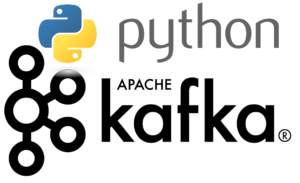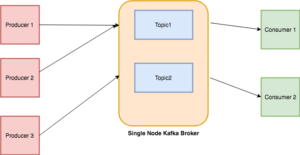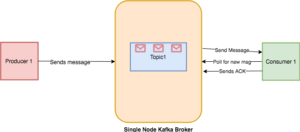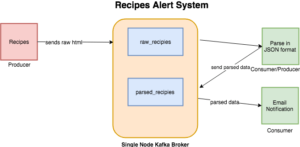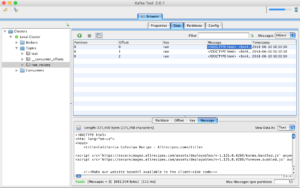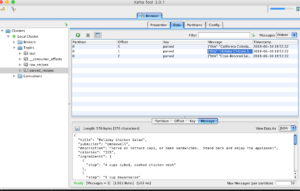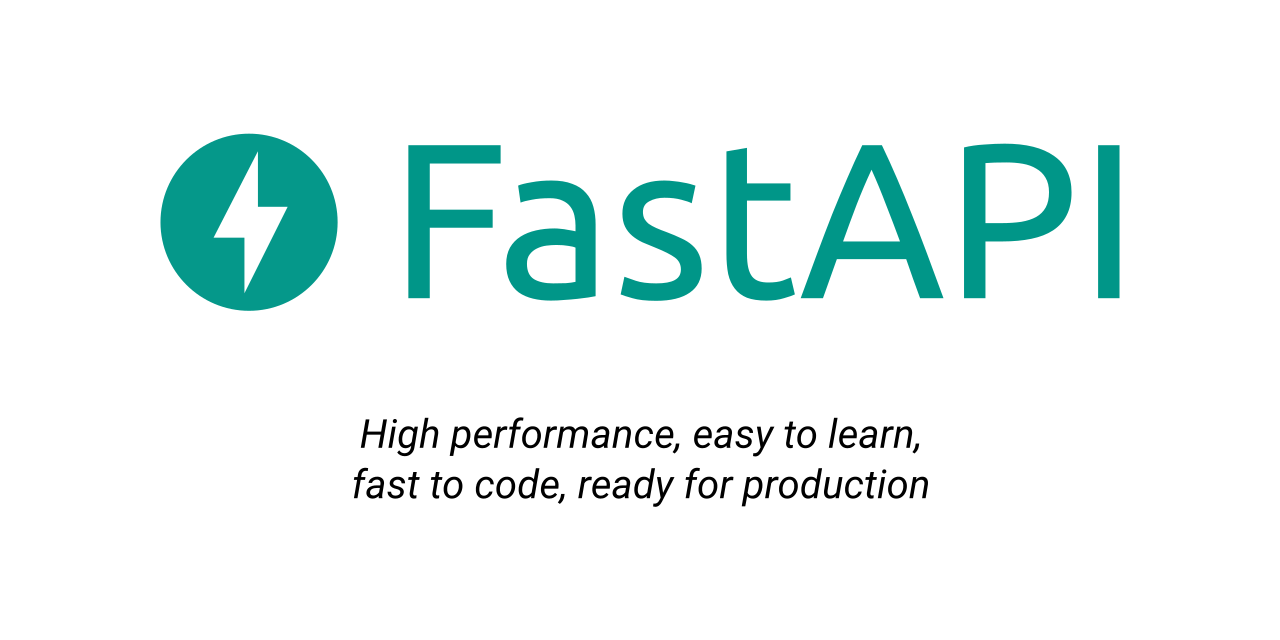This post is the part of Data Engineering Series.
In this post, I am going to discuss Apache Kafka and how Python programmers can use it for building distributed systems.
What is Apache Kafka?
Apache Kafka is an open-source streaming platform that was initially built by LinkedIn. It was later handed over to Apache foundation and open sourced it in 2011.
According to Wikipedia:
Apache Kafka is an open-source stream-processing software platform developed by the Apache Software Foundation, written in Scala and Java. The project aims to provide a unified, high-throughput, low-latency platform for handling real-time data feeds. Its storage layer is essentially a “massively scalable pub/sub message queue architected as a distributed transaction log,”[3] making it highly valuable for enterprise infrastructures to process streaming data. Additionally, Kafka connects to external systems (for data import/export) via Kafka Connect and provides Kafka Streams, a Java stream processing library.
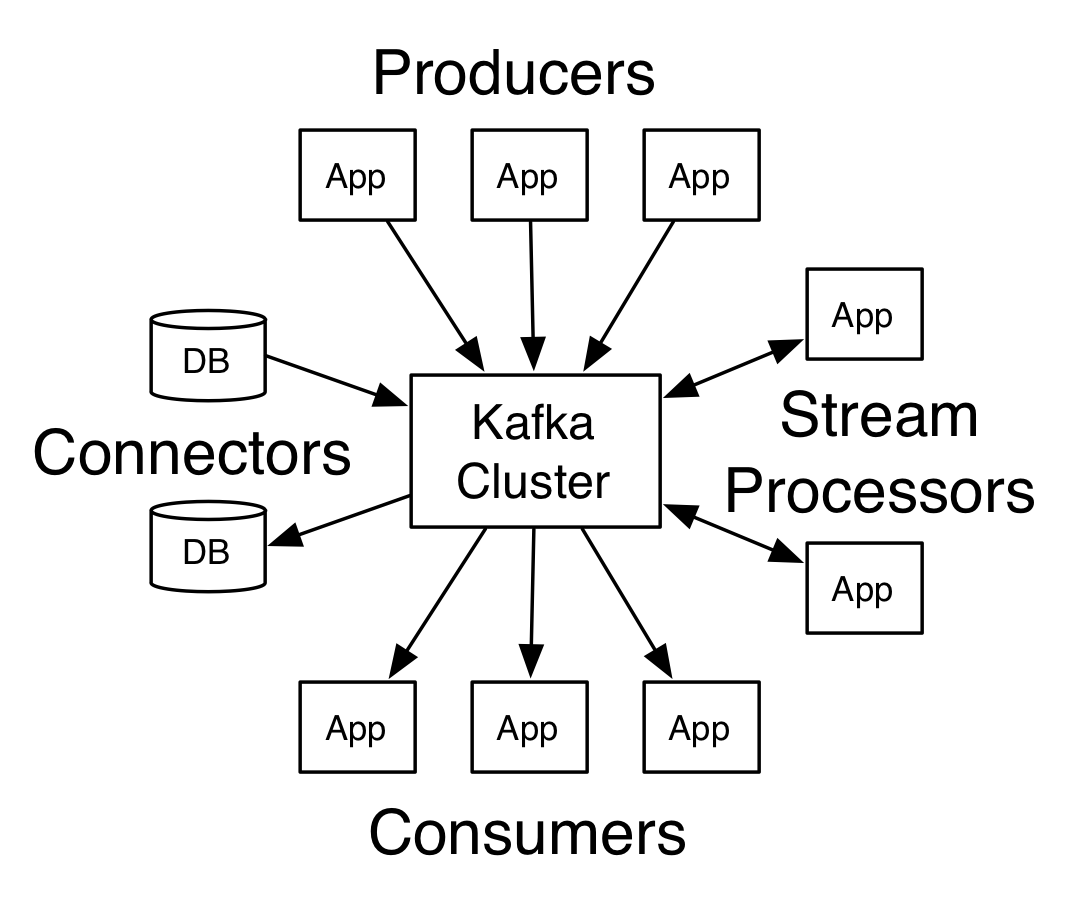
Think of it is a big commit log where data is stored in sequence as it happens. The users of this log can just access and use it as per their requirement.
Kafka Use Cases
Uses of Kafka are multiple. Here are a few use-cases that could help you to figure out its usage.
- Activity Monitoring:- Kafka can be used for activity monitoring. The activity could belong to a website or physical sensors and devices. Producers can publish raw data from data sources that later can be used to find trends and pattern.
- Messaging:- Kafka can be used as a message broker among services. If you are implementing a microservice architecture, you can have a microservice as a producer and another as a consumer. For instance, you have a microservice that is responsible to create new accounts and other for sending email to users about account creation.
- Log Aggregation:- You can use Kafka to collect logs from different systems and store in a centralized system for further processing.
- ETL:- Kafka has a feature of almost real-time streaming thus you can come up with an ETL based on your need.
- Database:- Based on things I mentioned above, you may say that Kafka also acts as a database. Not a typical databases that have a feature of querying the data as per need, what I meant that you can keep data in Kafka as long as you want without consuming it.
Kafka Concepts
Topics
Every message that is feed into the system must be part of some topic. The topic is nothing but a stream of records. The messages are stored in key-value format. Each message is assigned a sequence, called Offset. The output of one message could be an input of the other for further processing.
Producers
Producers are the apps responsible to publish data into Kafka system. They publish data on the topic of their choice.
Consumers
The messages published into topics are then utilized by Consumers apps. A consumer gets subscribed to the topic of its choice and consumes data.
Broker
Every instance of Kafka that is responsible for message exchange is called a Broker. Kafka can be used as a stand-alone machine or a part of a cluster.
I try to explain the whole thing with a simple example, there is a warehouse or godown of a restaurant where all the raw material is dumped like rice, vegetables etc. The restaurant serves different kinds of dishes: Chinese, Desi, Italian etc. The chefs of each cuisine can refer to the warehouse, pick the desire things and make things. There is a possibility that the stuff made by the raw material can later be used by all departments’ chefs, for instance, some secret sauce that is used in ALL kind of dishes. Here, the warehouse is a broker, vendors of goods are the producers, the goods and the secret sauce made by chefs are topics while chefs are consumers. My analogy might sound funny and inaccurate but at least it’d have helped you to understand the entire thing. 🙂
Setting up and Running
The easiest way to install Kafka is to download binaries and run it. Since it’s based on JVM languages like Scala and Java, you must make sure that you are using Java 7 or greater.
Kafka is available in two different flavors: One by Apache foundation and other by Confluent as a package. For this tutorial, I will go with the one provided by Apache foundation. By the way, Confluent was founded by the original developers of Kafka.
Starting Zookeeper
Kafka relies on Zookeeper, in order to make it run we will have to run Zookeeper first.
bin/zookeeper-server-start.sh config/zookeeper.properties
it will display lots of text on the screen, if see the following it means it’s up properly.
2018-06-10 06:36:15,023] INFO maxSessionTimeout set to -1 (org.apache.zookeeper.server.ZooKeeperServer) [2018-06-10 06:36:15,044] INFO binding to port 0.0.0.0/0.0.0.0:2181 (org.apache.zookeeper.server.NIOServerCnxnFactory)
Starting Kafka Server
Next, we have to start Kafka broker server:
bin/kafka-server-start.sh config/server.properties
And if you see the following text on the console it means it’s up.
2018-06-10 06:38:44,477] INFO Kafka commitId : fdcf75ea326b8e07 (org.apache.kafka.common.utils.AppInfoParser) [2018-06-10 06:38:44,478] INFO [KafkaServer id=0] started (kafka.server.KafkaServer)
Create Topics
Messages are published in topics. Use this command to create a new topic.
➜ kafka_2.11-1.1.0 bin/kafka-topics.sh --create --zookeeper localhost:2181 --replication-factor 1 --partitions 1 --topic test Created topic "test".
You can also list all available topics by running the following command.
➜ kafka_2.11-1.1.0 bin/kafka-topics.sh --list --zookeeper localhost:2181 test
As you see, it prints test.
Sending Messages
Next, we have to send messages, producers are used for that purpose. Let’s initiate a producer.
➜ kafka_2.11-1.1.0 bin/kafka-console-producer.sh --broker-list localhost:9092 --topic test >Hello >World
You start the console based producer interface which runs on the port 9092 by default. --topic allows you to set the topic in which the messages will be published. In our case the topic is test
It shows you a > prompt and you can input whatever you want.
Messages are stored locally on your disk. You can learn about the path of it by checking the value of log.dirs in config/server.properties file. By default they are set to /tmp/kafka-logs/
If you list this folder you will find a folder with name test-0. Upon listing it you will find 3 files: 00000000000000000000.index 00000000000000000000.log 00000000000000000000.timeindex
If you open 00000000000000000000.log in an editor then it shows something like
^@^@^@^@^@^@^@^@^@^@^@=^@^@^@^@^BÐØR^V^@^@^@^@^@^@^@^@^Acça<9a>o^@^@^Acça<9a>oÿÿÿÿÿÿÿÿÿÿÿÿÿÿ^@^@^@^A^V^@^@^@^A Hello^@^@^@^@^@^@^@^@^A^@^@^@=^@^@^@^@^BÉJ^B^@^@^@^@^@^@^@^@^Acça<9f>^?^@^@^Acça<9f>^?ÿÿÿÿÿÿÿÿÿÿÿÿÿÿ^@^@^@^A^V^@^@^@^A World^@ ~
Looks like the encoded data or delimiter separated, I am not sure. If someone knows this format then do let me know.
Anyways, Kafka provides a utility that lets you examine each incoming message.
➜ kafka_2.11-1.1.0 bin/kafka-run-class.sh kafka.tools.DumpLogSegments --deep-iteration --print-data-log --files /tmp/kafka-logs/test-0/00000000000000000000.log Dumping /tmp/kafka-logs/test-0/00000000000000000000.log Starting offset: 0 offset: 0 position: 0 CreateTime: 1528595323503 isvalid: true keysize: -1 valuesize: 5 magic: 2 compresscodec: NONE producerId: -1 producerEpoch: -1 sequence: -1 isTransactional: false headerKeys: [] payload: Hello offset: 1 position: 73 CreateTime: 1528595324799 isvalid: true keysize: -1 valuesize: 5 magic: 2 compresscodec: NONE producerId: -1 producerEpoch: -1 sequence: -1 isTransactional: false headerKeys: [] payload: World
You can see the message with other details like offset, position and CreateTime etc.
Consuming Messages
Messages that are stored should be consumed too. Let’s started a console based consumer.
➜ kafka_2.11-1.1.0 bin/kafka-console-consumer.sh --bootstrap-server localhost:9092 --topic test --from-beginning
If you run, it will dump all the messages from the beginning till now. If you are just interested to consume the messages after running the consumer then you can just omit --from-beginning switch it and run. The reason it does not show the old messages because the offset is updated once the consumer sends an ACK to the Kafka broker about processing messages. You can see the workflow below.
Accessing Kafka in Python
There are multiple Python libraries available for usage:
-
- Kafka-Python – An open-source community-based library.
- PyKafka – This library is maintained by Parsly and it’s claimed to be a Pythonic API. Unlike Kafka-Python you can’t create dynamic topics.
- Confluent Python Kafka:- It is offered by Confluent as a thin wrapper around librdkafka, hence it’s performance is better than the two.
For this post, we will be using the open-source Kafka-Python.
Recipes Alert System in Kafka
In the last post about Elasticsearch, I scraped Allrecipes data. In this post, I am going to use the same scraper as a data source. The system we are going to build is an alert system which will send notification about the recipes if it meets the certain threshold of the calories. There will be two topics:
- raw_recipes:- It will be storing the raw HTML of each recipe. The idea is to use this topic as the main source of our data that later can be processed and transformed as per need.
- parsed_recipes:- As the name suggests, this will be parsed data of each recipe in JSON format.
The length of Kafka topic name should not exceed 249.
A typical workflow will look like below:
Install kafka-python via pip
pip install kafka-python
Raw recipe producer
The first program we are going to write is the producer. It will access Allrecpies.com and fetch the raw HTML and store in raw_recipes topic.
https://gist.github.com/kadnan/20b0782b38eeb3bcecb6ea167f800d36
This code snippet will extract markup of each recipe and return in list format.
Next, we to create a producer object. Before we proceed further, we will make changes in config/server.properties file. We have to set advertised.listeners to PLAINTEXT://localhost:9092 otherwise you could experience the following error:
Error encountered when producing to broker b'adnans-mbp':9092. Retrying.
We will now add two methods:connect_kafka_producer() that will give you an instance of Kafka producer and publish_message() that will just dump the raw HTML of individual recipes.
https://gist.github.com/kadnan/ce1b05d4351a1b928f612b1e72593bfa
The __main__ will look like below:
if __name__ == '__main__':
headers = {
'User-Agent': 'Mozilla/5.0 (Macintosh; Intel Mac OS X 10_11_6) AppleWebKit/537.36 (KHTML, like Gecko) Chrome/66.0.3359.181 Safari/537.36',
'Pragma': 'no-cache'
}
all_recipes = get_recipes()
if len(all_recipes) > 0:
kafka_producer = connect_kafka_producer()
for recipe in all_recipes:
publish_message(kafka_producer, 'raw_recipes', 'raw', recipe.strip())
if kafka_producer is not None:
kafka_producer.close()
If it runs well, it shows the following output:
/anaconda3/anaconda/bin/python /Development/DataScience/Kafka/kafka-recipie-alert/producer-raw-recipies.py Accessing list Processing..https://www.allrecipes.com/recipe/20762/california-coleslaw/ Processing..https://www.allrecipes.com/recipe/8584/holiday-chicken-salad/ Processing..https://www.allrecipes.com/recipe/80867/cran-broccoli-salad/ Message published successfully. Message published successfully. Message published successfully. Process finished with exit code 0
I am using a GUI tool, named as Kafka Tool to browse recently published messages. It is available for OSX, Windows and Linux.
Recipe Parser
The next script we are going to write will serve as both consumer and producer. First it will consume data from raw_recipes topic, parse and transform data into JSON and then will publish it in parsed_recipes topic. Below is the code that will fetch HTML data from raw_recipes topic, parse and then feed into parsed_recipes topic.
https://gist.github.com/kadnan/a91554d7aedf89a7fca85956bc4da2c4
KafkaConsumer accepts a few parameters beside the topic name and host address. By providing auto_offset_reset='earliest' you are telling Kafka to return messages from the beginning. The parameter consumer_timeout_ms helps the consumer to disconnect after the certain period of time. Once disconnected, you can close the consumer stream by calling consumer.close()
After this, I am using same routines to connect producers and publish parsed data in the new topic. KafaTool browser gives glad tidings about newly stored messages.
So far so good. We stored recipes in both raw and JSON format for later use. Next, we have to write a consumer that will connect with parsed_recipes topic and generate alert if certain calories critera meets.
https://gist.github.com/kadnan/7503d1bdc995086830f5ae4d2b895828
The JSON is decoded and then check the calories count, a notification is issued once the criteria meet.
Conclusion
Kafka is a scalable, fault-tolerant, publish-subscribe messaging system that enables you to build distributed applications. Due to its high performance and efficiency, it’s getting popular among companies that are producing loads of data from various external sources and want to provide real-time findings from it. I have just covered the gist of it. Do explore the docs and existing implementation and it will help you to understand how it could be the best fit for your next system.
The code is available on Github.
Header Image Credit: linuxhint.com
